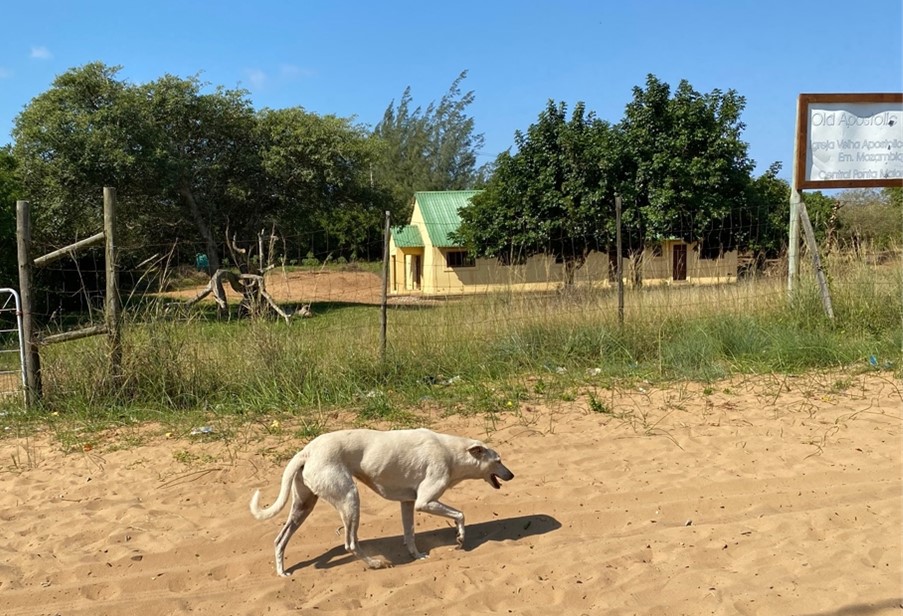Dog lying in the sand in a street of Malongane, Mozambique. Studies have shown that most of the roaming dogs observed in African villages are, in fact, owned and the stray dog population usually does not exceed 10% of the overall dog population [5], [7], [10]. Picture (c) C. Goulet (Colibri) 2021.
Rabies is a viral zoonosis, responsible for fatal encephalitis. Despite the existence of effective prophylaxis, the number of human rabies deaths remains a concern (59 000 deaths per year), Africa and Asia being the most affected (95%) [1].
The animal maintenance host of rabies is mostly the domestic dog with the role of wildlife suspected in rare contexts [2]–[4]. However, knowing that 99% of human rabies deaths are linked to dog-bites, controlling canine rabies in Africa should drastically reduce the number of human cases [1] and possibly entirely eliminate human deaths by rabies by 2030.
Targeting domestic dogs through mass dog vaccination campaigns is the method of choice despite its costs. However, the turn-over in African dog populations remains a great challenge in order to reach the expected 70% coverage recommended by WHO (e.g. in Zambia, 29% of dogs < 1 year-old with 57.7% < 3-months old; dog’s life expectancy = 3.15 years [5]). Therefore, in some cases, vaccination needs to be associated with dog population management programmes, also expensive (e.g. sterilization) [6]. Usually, both activities fall under the Veterinary Services’ responsibility, reducing costs for the medical sector by greatly reducing the human Post-Exposition-Prophylaxis demand [7]. Unfortunately, Veterinary Services often sorely lack the funds and human resources to implement these activities as confirmed by a general review of 165 PVS missions realised over the past 12 years in Africa (personal communication, 2019).
Still, success stories in strengthening surveillance programmes at country and regional level exist [8], [9]. Unfortunately, the absence of reliable data on rabies cases in both humans and dogs remains one of the big challenges in raising awareness and encouraging governmental institutions to invest in coordinated and targeted programmes. Such One Health programmes would involve both human and animal health institutions (educational programmes/awareness-raising campaigns) for efficient and joint human and animal surveillance programmes.
This lack of rabies data has been linked to misdiagnosis [7], [9], [11], [12] and under-reporting mainly due to the absence of laboratory confirmation [7], [11]. Indeed, the gold standard for rabies diagnosis, recommended by OIE and WHO, is the direct Immunofluorescent antibody (DFA) test that requires the use of costly materials that are not always available in regular laboratories, especially in developing countries [13]. Thus, the use of new decentralized, cheaper, quicker and easy-to-use laboratory tests, such as the dRIT [13] opens new opportunities for low-income countries to reinforce their rabies surveillance system [14], [15]. Mobile technologies, which are cheap and easy-to-use tools, have also been tested to improve health and surveillance systems for rabies [8], [14]. Even if coverage is not always perfect in all African countries, the network is growing fast and improving quickly. A mobile-phone-based surveillance system for rabies was tested successfully in southern Tanzania showing improvements in timeliness, completeness, cost-effectiveness and quality of data [8].
Rabies is the One Health disease by excellence as human cases are directly linked to animals and both need to be addressed together to achieve elimination. Considering the estimated health and economic burden of rabies (1.28 billion USD for Africa [1]), investments in coordinated and targeted actions and in the strengthening of integrated surveillance systems to collect accurate data in human and animal will bring relief to countries.
Recently, success stories, the development of tools and new technologies bring new perspectives and make the possibility of eradicating rabies by 2030 in Africa more attainable.
Owned-dog roaming freely in Ponta de Ouro’s street, Mozambique. Picture (c) C. Goulet (Colibri) 2021.
However, the specificities of the African continent need to be considered to design regional scale programmes (e. g. transnational migrating populations, practical and cultural domestic dog management, transfrontier conservation areas). A holistic rabies surveillance programme should be fully integrated in disease surveillance systems and financially supported by states and international donors.
REFERENCES:
[1] K. Hampson et al., “Estimating the Global Burden of Endemic Canine Rabies,” PLoS Negl. Trop. Dis., vol. 9, no. 4, pp. 1–20, 2015, doi: 10.1371/journal.pntd.0003709.
[2] E. H. Hikufe et al., “Ecology and epidemiology of rabies in humans, domestic animals and wildlife in Namibia, 2011-2017,” PLoS Negl. Trop. Dis., vol. 13, no. 4, pp. 2011–2017, 2019, doi: 10.1371/journal.pntd.0007355.
[3] M. Grover et al., “Spatiotemporal epidemiology of rabies at an interface between domestic dogs and wildlife in South Africa,” Sci. Rep., no. July, pp. 1–9, 2018, doi: 10.1038/s41598-018-29045-x.
[4] K. N. Koeppel and P. N. Thompson, “Patterns of rabies cases in South Africa between 1993 and 2019 , including the role of wildlife,” no. March, pp. 1–13, 2021, doi: 10.1111/tbed.14080.
[5] C. Kaneko et al., “Domestic dog demographics and estimates of canine vaccination coverage in a rural area of Zambia for the elimination of rabies,” pp. 1–22, 2021, doi: 10.1371/journal.pntd.0009222.
[6] L. H. Taylor et al., “The role of dog population management in rabies elimination-A review of current approaches and future opportunities,” Front. Vet. Sci., vol. 4, no. JUL, 2017, doi: 10.3389/fvets.2017.00109.
[7] T. Lembo et al., “The feasibility of canine rabies elimination in Africa: Dispelling doubts with data,” PLoS Negl. Trop. Dis., vol. 4, no. 2, 2010, doi: 10.1371/journal.pntd.0000626.
[8] Z. Mtema et al., “Mobile Phones As Surveillance Tools: Implementing and Evaluating a Large-Scale Intersectoral Surveillance System for Rabies in Tanzania,” PLoS Med., vol. 13, no. 4, pp. 1–12, 2016, doi: 10.1371/journal.pmed.1002002.
[9] A. Broban, M. C. Tejiokem, I. Tiembré, S. Druelles, and M. L’Azou, “Bolstering human rabies surveillance in Africa is crucial to eliminating canine-mediated rabies,” PLoS Negl. Trop. Dis., vol. 12, no. 9, pp. 1–7, 2018, doi: 10.1371/journal.pntd.0006367.
[10] T. Jibat, H. Hogeveen, and M. C. M. Mourits, “Review on Dog Rabies Vaccination Coverage in Africa: A Question of Dog Accessibility or Cost Recovery?,” PLoS Negl. Trop. Dis., vol. 9, no. 2, pp. 1–13, 2015, doi: 10.1371/journal.pntd.0003447.
[11] L. H. Nel, “Discrepancies in data reporting for rabies, Africa,” Emerg. Infect. Dis., vol. 19, no. 4, pp. 529–533, 2013, doi: 10.3201/eid1904.120185.
[12] M. Mallewa et al., “Rabies encephalitis in malaria-endemic area, Malawi, Africa,” Emerg. Infect. Dis., vol. 13, no. 1, pp. 136–139, 2007, doi: 10.3201/eid1301.060810.
[13] S. Dürr et al., “Rabies diagnosis for developing countries,” PLoS Negl. Trop. Dis., vol. 2, no. 3, 2008, doi: 10.1371/journal.pntd.0000206.
[14] A. Coetzer, J. Coertse, M. J. Makalo, M. Molomo, W. Markotter, and L. H. Nel, “Epidemiology of rabies in Lesotho: The importance of routine surveillance and virus characterization,” Trop. Med. Infect. Dis., vol. 2, no. 3, pp. 1–14, 2017, doi: 10.3390/tropicalmed2030030.
[15] E. U. Ukamaka et al., “Economic and feasibility comparison of the drit and dfa for decentralized rabies diagnosis in resource-limited settings: The use of nigerian dog meat markets as a case study,” PLoS Negl. Trop. Dis., vol. 14, no. 2, pp. 1–18, 2020, doi: 10.1371/journal.pntd.0008088.


